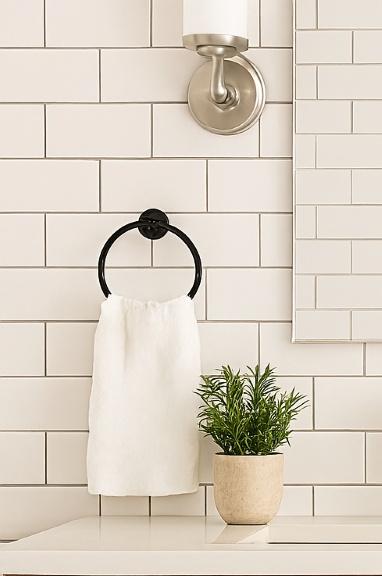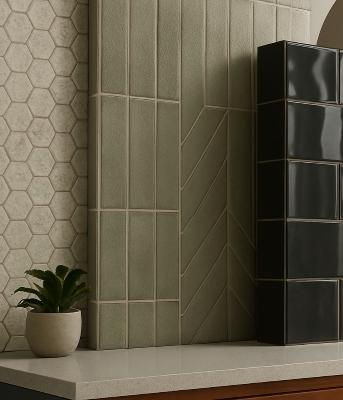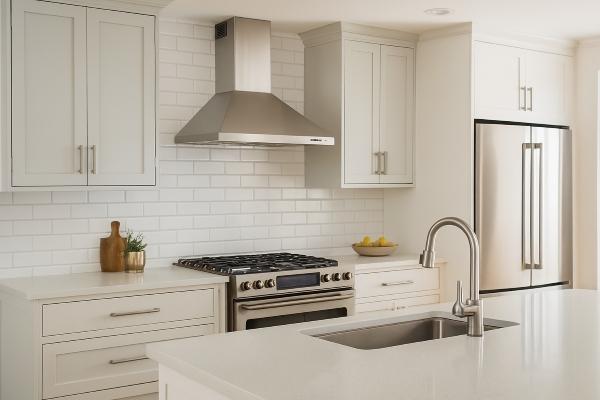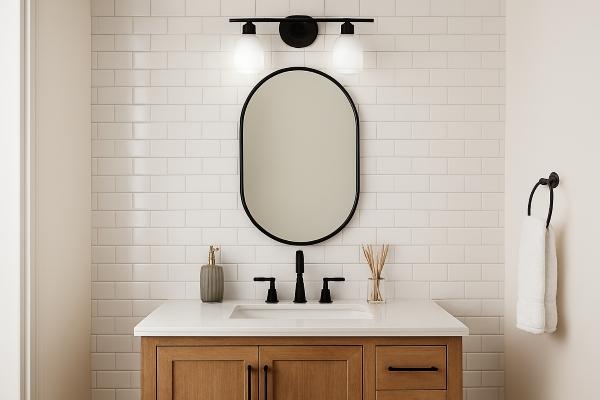Subway tiles have evolved far beyond their original underground railway stations to become one of the most versatile and enduring design elements in modern architecture and interior design. These rectangular ceramic tiles, typically measuring 3x6 inches, offer unparalleled flexibility for contemporary homes, commercial spaces, and innovative design applications. From traditional white kitchen backsplashes to bold statement walls in vibrant colors and varied patterns, subway tiles provide both aesthetic appeal and practical functionality that makes them the go-to choice for designers, contractors, and homeowners seeking reliable, stylish solutions for any space.
The Evolution of Subway Tiles in Contemporary Design
The journey of subway tiles from utilitarian transit infrastructure to coveted design element represents one of the most successful transformations in architectural history. Originally installed in New York City's subway system in 1904, these tiles were chosen for their durability, ease of cleaning, and ability to reflect light in dark underground spaces. Today's modern applications have expanded exponentially beyond these practical origins.
Contemporary designers now embrace subway tiles for their chameleon-like ability to adapt to any design style. Whether you're browsing Nova Tile and Stone's extensive collection or exploring local showrooms, you'll discover that modern subway tiles come in dozens of colors, finishes, and sizes that cater to every aesthetic preference.
The versatility extends to installation patterns as well. While the traditional running bond pattern remains popular, modern applications include herringbone, vertical stacking, and diagonal arrangements that create entirely different visual impacts. This flexibility allows homeowners and designers to achieve unique looks while maintaining the classic appeal that makes subway tiles timelessly relevant.
Beyond the Basic Backsplash
Kitchens remain the primary showcase for subway tile innovation. The traditional white 3x6 inch tile backsplash continues to dominate kitchen designs, but modern applications push creative boundaries in exciting ways. Today's kitchen designers are experimenting with tiles by color to create focal points that complement cabinetry and countertops.
Large-format subway tiles, measuring 4x8 or even 6x12 inches, create cleaner lines and require fewer grout joints, resulting in easier maintenance and a more contemporary appearance. These larger tiles work particularly well in modern and minimalist kitchen designs where simplicity and functionality take precedence.
Color variations have transformed kitchen backsplashes from purely functional elements into design statements. Sage green subway tiles complement natural wood cabinetry, while navy blue creates striking contrast against white or cream-colored kitchens. According to House Beautiful's bathroom and kitchen remodel ideas, colored subway tiles are trending as homeowners seek personalized spaces that reflect their individual style preferences.
Installation techniques have also evolved significantly. The traditional offset pattern remains popular, but vertical installations create the illusion of higher ceilings, while herringbone patterns add sophisticated texture without overwhelming smaller spaces. Professional installers recommend consulting ceramic tile installation resources to ensure proper technique and long-lasting results.
Bathroom Transformations with Modern Subway Tiles
Bathrooms present unique opportunities for creative subway tile applications. The moisture-resistant properties that made these tiles perfect for subway tunnels translate perfectly to bathroom environments. Modern bathroom designs incorporate subway tiles in shower surrounds, accent walls, and even flooring applications when properly sealed and maintained.
Shower installations showcase subway tiles' water-resistance capabilities while providing endless design possibilities. Floor-to-ceiling installations in neutral tones create spa-like atmospheres, while accent strips in contrasting colors add visual interest without overwhelming compact spaces. The key lies in selecting appropriate tiles by style that complement existing fixtures and overall design themes.
Maintenance considerations become crucial in bathroom applications. Easy cleaning tips for porcelain tile emphasize regular cleaning schedules and appropriate cleaning products that preserve tile appearance and grout integrity. Proper installation and sealing prevent water damage and ensure longevity in high-moisture environments.
Size variations play important roles in bathroom design success. Standard 3x6 inch tiles work well in most bathroom applications, but larger formats can make small bathrooms appear more spacious by reducing visual interruption from grout lines. Conversely, smaller subway tiles or mosaic arrangements add textural interest in powder rooms or accent areas where intricate detail enhances intimate spaces.
Commercial and Retail Applications
Commercial applications demonstrate subway tiles' durability and aesthetic versatility in high-traffic environments. Restaurants, retail stores, and office buildings utilize subway tiles for both functional and branding purposes. The tiles' easy maintenance and timeless appeal make them cost-effective solutions for businesses seeking long-term design investments.

Retail environments benefit from subway tiles' neutral backdrop qualities that allow merchandise to take center stage while maintaining sophisticated ambiance. Restaurant applications range from traditional white installations that emphasize cleanliness and freshness to bold colored arrangements that reinforce brand identity and create memorable dining experiences.
Professional installation becomes critical in commercial settings where durability and appearance standards exceed residential requirements. Professional tile installation guides provide detailed specifications for commercial-grade installations that withstand heavy use and frequent cleaning without compromising appearance.
Creative Pattern Innovations and Installation Techniques
Modern subway tile installations go far beyond simple running bond patterns. Creative arrangements include herringbone, vertical stack, diagonal, and even complex geometric combinations that transform simple rectangular tiles into sophisticated design statements. Each pattern creates different visual effects and serves specific design purposes.
Herringbone patterns add movement and sophistication to subway tile installations. This arrangement works particularly well in larger spaces where the pattern complexity can be fully appreciated. The zigzag effect creates visual interest without requiring different tile shapes or colors, making it a cost-effective way to achieve designer looks.
Vertical installations elongate spaces and create dramatic effects, particularly effective in bathrooms with standard ceiling heights. This pattern works exceptionally well with different tile sizes where longer formats emphasize the vertical emphasis even more dramatically.
Installation considerations vary significantly between patterns. Subway tile backsplash installation guides provide detailed instructions for achieving professional results with various pattern configurations. Proper planning, measurement, and tool selection ensure successful installations regardless of pattern complexity.
Color and Finish Options in Modern Markets
The color palette for subway tiles has expanded dramatically from the original white glazed ceramic. Today's options include virtually every color imaginable, from subtle earth tones to bold jewel colors that create striking focal points in any space.Nova Tile and Stone's product selection exemplifies the vast range of contemporary options available to designers and homeowners.
Finish variations add another dimension to subway tile selection. Glossy finishes reflect light and create bright, clean appearances that work well in kitchens and bathrooms. Matte finishes provide subtle sophistication and hide water spots and fingerprints better than glossy alternatives, making them practical choices for high-use areas.
Textured finishes introduce tactile elements that add depth and interest to installations. These finishes work particularly well in accent applications where texture enhances visual appeal without overwhelming primary surfaces. The key lies in balancing textured elements with smoother surfaces to create harmonious compositions.
Understanding different types of tiles and their characteristics helps inform selection decisions based on specific application requirements. Porcelain subway tiles offer superior durability and stain resistance, while ceramic options provide cost-effective solutions for most residential applications.
Size Variations and Their Impact on Space Perception
Traditional 3x6 inch subway tiles remain popular, but modern manufacturing offers numerous size variations that serve different design purposes. Larger formats like 4x8, 4x12, and 6x12 inches create more contemporary appearances with fewer grout lines and easier maintenance requirements.
Smaller variations, including 2x4 and 2x6 inch options, work well in compact spaces or detailed applications where traditional sizes might appear overwhelming. These smaller formats also work effectively in mosaic arrangements or border applications that require more intricate detailing.
The relationship between tile size and space perception proves crucial in design success. Larger tiles generally make spaces appear bigger by reducing visual fragmentation, while smaller tiles can add intimacy and detailed interest to larger spaces. Professional designers often recommend consulting with local tile specialists to determine optimal sizing for specific applications.
Calculating tile quantities accurately prevents project delays and ensures consistent color matching across installations.Tile quantity calculation guides provide formulas and considerations for accurate material estimation based on room dimensions and waste factors.
Maintenance and Longevity Considerations
Proper maintenance ensures subway tile installations retain their beauty and functionality for decades. The same characteristics that made these tiles suitable for subway tunnels - durability, stain resistance, and easy cleaning - make them excellent long-term investments for modern applications.
Daily maintenance involves simple cleaning with appropriate products that preserve tile and grout appearance. Avoiding harsh chemicals and abrasive cleaners prevents damage to glazed surfaces and grout joints. Regular cleaning prevents buildup of soap scum, grease, and other substances that can discolor or damage tile installations over time.
Grout maintenance requires special attention since grout joints are more porous than tile surfaces. Proper sealing during installation and periodic resealing maintain water resistance and prevent staining.Professional tile replacement guides provide detailed instructions for addressing damaged tiles without compromising surrounding installations.
Long-term care includes periodic professional cleaning and inspection to identify potential problems before they require extensive repairs. Quality installations with proper maintenance can last for decades while maintaining their original appearance and functionality.
Future Trends and Innovations
The subway tile market continues evolving with new materials, finishes, and application techniques that expand design possibilities. Digital printing technology enables photo-realistic patterns and textures that mimic natural materials while maintaining the practical benefits of ceramic and porcelain construction.

Sustainable manufacturing practices increasingly influence tile production, with recycled content and environmentally responsible manufacturing processes becoming standard industry practices. These developments align with growing consumer interest in eco-friendly building materials that reduce environmental impact without compromising performance or appearance.
Technology integration represents another emerging trend, with smart tiles incorporating LED lighting, heating elements, or other functional features that expand beyond traditional decorative and protective roles. While still in early development stages, these innovations suggest exciting possibilities for future subway tile applications.
Design trend forecasting indicates continued popularity for subway tiles in both traditional and innovative applications. The timeless rectangular format provides a stable foundation for creative expression while maintaining the practical benefits that originally made these tiles successful in demanding subway environments.
Conclusion
Subway tiles have successfully transitioned from purely functional transit infrastructure elements to versatile design components that enhance modern residential and commercial spaces. Their enduring popularity stems from the perfect combination of timeless aesthetic appeal, practical functionality, and limitless creative possibilities. Whether you're planning a simple kitchen backsplash update or a comprehensive bathroom renovation, subway tiles offer reliable solutions that adapt to any design vision while providing long-term value and satisfaction.
The key to successful subway tile applications lies in understanding the vast array of options available and selecting appropriate combinations of size, color, pattern, and installation technique that serve your specific needs and preferences. By working with experienced suppliers like Nova Tile and Stone and following professional installation guidelines, you can achieve stunning results that will enhance your space for years to come.
For personalized assistance with your subway tile project, contact our design specialists who can help you navigate the extensive options and create the perfect solution for your unique application requirements.
Frequently Asked Questions
What are the standard sizes available for subway tiles?
Traditional subway tiles measure 3x6 inches, but modern manufacturing offers numerous size variations including 2x4, 2x6, 4x8, 4x12, and 6x12 inches. Larger formats create more contemporary appearances with fewer grout lines, while smaller sizes work well in detailed applications or compact spaces. The choice depends on your specific design goals and space requirements.
How do I choose the right grout color for my subway tile installation?
Grout color significantly impacts the overall appearance of your installation. White or light gray grout creates seamless, clean looks that emphasize tile color and pattern. Contrasting dark grout highlights individual tiles and creates more defined geometric patterns. Consider your maintenance preferences as well - darker grout colors hide stains better than white alternatives.
Can subway tiles be used on floors, or are they only for walls?
While subway tiles are most commonly used for wall applications, they can be successfully installed on floors when properly selected and installed. Choose tiles with appropriate slip resistance ratings for floor applications, and ensure proper substrate preparation and installation techniques. Consult with professional installers to determine suitability for your specific flooring needs.
What's the difference between ceramic and porcelain subway tiles?
Ceramic subway tiles are made from clay and fired at lower temperatures, making them more affordable and suitable for most residential applications. Porcelain tiles are fired at higher temperatures, creating denser, more durable tiles with superior stain resistance and lower water absorption rates. Porcelain tiles cost more but offer better performance in high-moisture environments and commercial applications.
How much maintenance do subway tile installations require?
Subway tiles require minimal maintenance when properly installed. Daily cleaning involves simple wiping with appropriate cleaners, avoiding harsh chemicals that can damage glazed surfaces or grout. Periodic grout cleaning and sealing maintain water resistance and appearance. With proper care, quality subway tile installations can maintain their beauty and functionality for decades with minimal ongoing maintenance.
Would you like more information
about a product?

